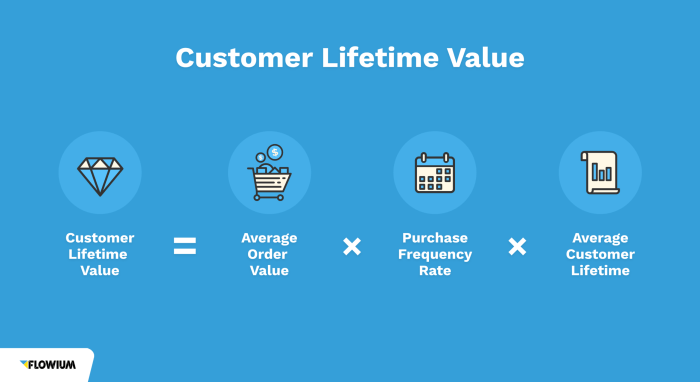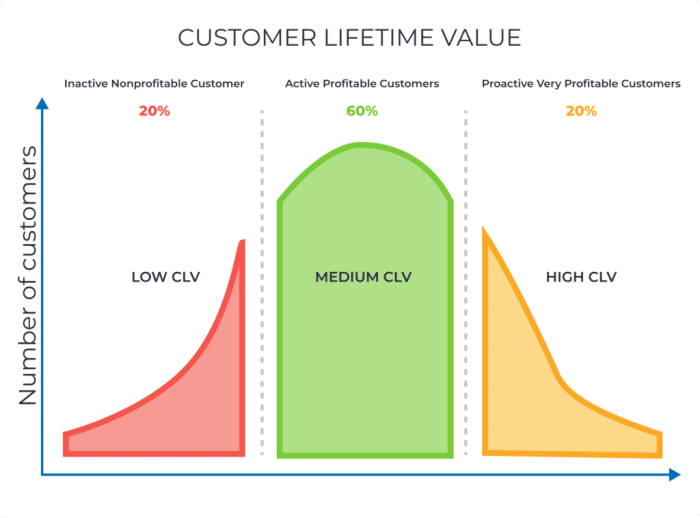Understanding Lifetime Customer Value is a key factor in shaping the success of businesses, influencing profitability and customer relationships. Get ready to dive into the world of LCV with a mix of strategy, calculation, and real-world examples that will leave you wanting more.
Overview of Lifetime Customer Value

Lifetime Customer Value (LCV) is a crucial metric that helps businesses determine the total revenue they can expect from a customer throughout their entire relationship. It takes into account not just the initial purchase but also the potential for repeat purchases, referrals, and other forms of engagement.
Understanding LCV is essential for businesses as it allows them to make informed decisions about marketing strategies, customer retention efforts, and overall business growth. By knowing the long-term value of each customer, companies can allocate resources more effectively and tailor their offerings to maximize profitability.
Calculating Lifetime Customer Value
Businesses can calculate LCV by considering factors such as average purchase value, purchase frequency, customer lifespan, and referral value. By analyzing these metrics, companies can estimate the total revenue generated by a customer over time.
LCV = (Average Purchase Value x Purchase Frequency) x Customer Lifespan
Utilizing Lifetime Customer Value
Once LCV is determined, businesses can use this information to improve customer relationship management, personalize marketing campaigns, and enhance overall customer experience. By focusing on maximizing LCV, companies can foster long-term customer loyalty and drive sustainable growth.
Factors Influencing Lifetime Customer Value
When it comes to determining Lifetime Customer Value (LCV), there are several key factors that play a crucial role in influencing this metric. Factors such as customer retention, average order value, and purchase frequency are vital in calculating and maximizing LCV for a business.
Customer Retention
Customer retention is one of the most significant factors impacting LCV. By retaining customers and keeping them engaged with the brand over an extended period, businesses can increase the overall value that each customer brings. Strategies such as providing excellent customer service, personalized experiences, and loyalty programs can help in improving customer retention rates.
Average Order Value
The average order value is another essential factor in determining LCV. Businesses that focus on increasing the average amount customers spend per transaction can significantly impact their overall LCV. By upselling or cross-selling products, offering bundles, or running promotions, businesses can boost their average order value and ultimately increase LCV.
Purchase Frequency
Purchase frequency refers to how often customers make a purchase from a particular business. Increasing purchase frequency can have a direct impact on LCV, as more purchases lead to higher revenue generated from each customer over their lifetime. Encouraging repeat purchases through targeted marketing campaigns, rewards programs, and exclusive offers can help in boosting purchase frequency and, in turn, LCV.
Industry Variances
Different industries and business models may prioritize these factors differently based on their unique characteristics and customer behavior. For example, a subscription-based business model may focus more on customer retention and purchase frequency to ensure recurring revenue streams, while a luxury brand may prioritize average order value by offering high-end products and exclusive experiences.
Customer Satisfaction and Loyalty Programs
Customer satisfaction plays a crucial role in influencing LCV, as happy customers are more likely to make repeat purchases and become loyal advocates for the brand. Implementing loyalty programs that reward customers for their continued support can further enhance LCV by incentivizing repeat business and fostering long-term relationships with customers.
Personalized Experiences
Personalization is key in today’s competitive market, as customers expect tailored experiences that cater to their individual preferences and needs. By offering personalized recommendations, targeted promotions, and customized communication, businesses can create a unique bond with customers that leads to increased loyalty, higher retention rates, and ultimately, a higher LCV.
Calculating Lifetime Customer Value: Understanding Lifetime Customer Value

In order to determine the Lifetime Customer Value (LCV) of a customer, businesses often use various methods to calculate this crucial metric. From simple formulas to more complex models, accurate data and analytics play a key role in deriving the LCV.
Methods of Calculating LCV
- Simple Formula: One of the most basic ways to calculate LCV is by using the following formula:
LCV = Average Purchase Value x Average Number of Purchases in a Year x Average Customer Lifespan
. This formula provides a quick estimate of the LCV based on key factors.
- Customer Segmentation: Businesses can also calculate LCV by segmenting their customers based on different characteristics such as demographics, behavior, and purchase history. This allows for a more personalized approach in determining LCV for each segment.
- Predictive Analytics: Utilizing advanced data analytics and predictive modeling, businesses can forecast future customer behavior and spending patterns to calculate a more accurate LCV. Predictive analytics can help in identifying high-value customers and tailoring marketing strategies accordingly.
Determining LCV for Your Business
- Collect Data: Start by gathering relevant data on customer purchases, frequency of transactions, and customer retention rates. Accurate data is crucial in calculating LCV effectively.
- Calculate Average Purchase Value: Determine the average amount a customer spends on each purchase. This can be calculated by dividing the total revenue by the number of purchases.
- Estimate Customer Lifespan: Analyze historical data to estimate how long a customer typically stays loyal to your business. This can help in determining the customer lifespan for calculating LCV.
- Factor in Customer Acquisition Cost: Consider the cost of acquiring a new customer when calculating LCV. Subtracting the customer acquisition cost from the LCV can provide a more accurate representation of the customer’s value.
Importance of Accurate Data and Analytics
Accurate data and analytics are essential in calculating LCV effectively as they provide insights into customer behavior, preferences, and purchasing patterns. By leveraging data-driven strategies, businesses can optimize their marketing efforts, improve customer retention, and maximize the value of each customer over their lifetime.
Strategies to Enhance Lifetime Customer Value
Increasing Lifetime Customer Value (LCV) is crucial for businesses looking to maximize their revenue and profitability. By implementing effective strategies, companies can not only retain existing customers but also increase their overall value over time.
Upselling and Cross-Selling
One common strategy to enhance LCV is through upselling and cross-selling. Upselling involves persuading customers to purchase a higher-end product or service, while cross-selling encourages them to buy complementary items. By offering upgrades or additional products, businesses can increase the average purchase value and customer lifetime value.
Personalized Marketing
Another effective way to enhance LCV is through personalized marketing. By leveraging customer data and insights, businesses can tailor their marketing messages and offers to individual preferences and behaviors. This personalized approach not only enhances the customer experience but also fosters stronger customer loyalty and repeat purchases.
Customer Segmentation and Targeting
Customer segmentation involves dividing the customer base into distinct groups based on demographics, behavior, or preferences. By segmenting customers and targeting specific groups with personalized marketing campaigns, businesses can effectively increase LCV. Understanding the unique needs and preferences of each segment allows companies to provide targeted offers and recommendations that resonate with customers, leading to higher retention rates and increased lifetime value.
Real-World Examples, Understanding Lifetime Customer Value
Renowned companies like Amazon and Netflix have successfully implemented strategies to enhance LCV. Amazon’s recommendation system analyzes customer behavior and preferences to offer personalized product suggestions, leading to increased cross-selling and repeat purchases. Netflix utilizes customer data to recommend personalized content, increasing customer engagement and retention. These examples highlight the importance of leveraging data and personalization to drive LCV growth.
